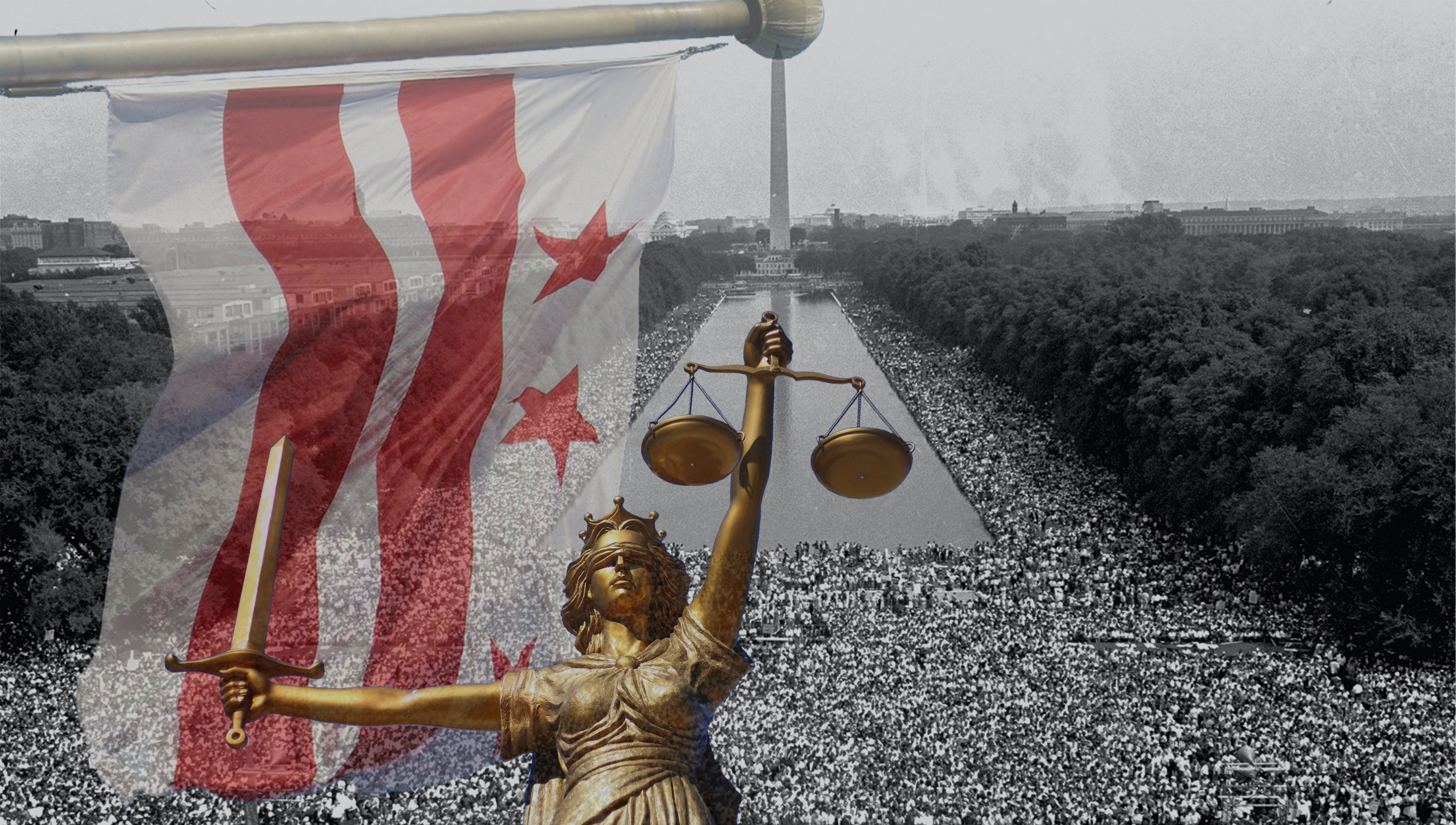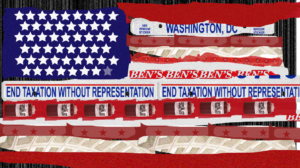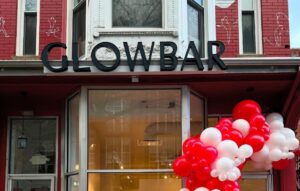When Jamal Holtz marches on Aug. 28, he will be thinking about his mother. Aalayah Eastmond will be thinking about her classmates. And Mia Young (NHS ’23) will be thinking about Washington, the city she grew up in, where she and her neighbors are denied representation in Congress.
Fifty-eight years after Dr. Martin Luther King Jr.’s March on Washington, these demonstrators and thousands more will walk in the reverend’s footsteps. History will not just be memorialized, but paralleled.
The original 1963 March on Washington for Jobs and Freedom convened more than 250,000 demonstrators under the leadership of King, A. Philip Randolph, Bayard Rustin, and many others, calling on Congress to end Jim Crow as well as Black soldiers’ exclusion from World War II and New Deal jobs. The day culminated in Dr. King’s oft- cited speech, “I Have a Dream.”
This August, the annual March on Washington is convening once more. Demonstrators are gathering to support legislation that would protect the voting rights of Black, brown, and Indigenous Americans against a wave of state laws designed to disenfranchise them.
The organizers for the March on Washington for Voting Rights call the gathering a “nonviolent, nonpartisan mass mobilization to demand that elected officials protect democracy, denounce voter suppression and ensure fair, easy access to the vote for all.” The march will begin at McPherson Square Park at 15th Street, NW, and H Stree at 8 a.m. on the 28th and stop at various points along the National Mall, including the steps of the Lincoln Memorial.
This march is especially personal to Washingtonians. Without statehood, none of the District’s over 700,000 residents have representation in Congress—a wrong they place in the same category as all other forms of voter suppression.
“We’re not just marching on Washington, we’re marching for Washington,” Holtz said.
Holtz is a lead organizer of 51 for 51, a campaign to make D.C. the 51st state with congressional representation using only 51 votes in the Senate. 51 for 51 sees their push for statehood as a matter of civil rights for what would be the only majority-minority state in the union. The filibuster, a Senate rule that requires 60 votes to start debate on an issue, currently blocks statehood. Advocates like Holtz see this as a continuation of the filibuster’s historical use— preventing the advancement of civil rights legislation for over a century.
The march also aims to direct public attention to numerous states’ attempts to restrict ballot access since the 2020 presidential election. This year, over 400 bills have been introduced in 49 U.S. states that limit voting access. New measures include bans on ballot drop boxes, fully ending or placing more stringent qualifications on mail-in voting, fewer early voting days and hours, the establishment of partisan election review boards, and even bans on distributing water to voters waiting in line to cast their ballots.
In addition to D.C., the Aug. 28 protest will see flagship marches in Atlanta, Miami, Houston, and Phoenix, and over 19 sister marches across the nation. Marchers like Holtz, who were born and raised in the District, especially understand the need for full representation. “Not only do we need to advocate against the sweep of voting rights suppression that’s happening across the country, but the voter suppression that’s happening right here in the District of Columbia,” he said.
The achievement of D.C. statehood is an act of protection not just for Holtz’s District community, but one for his family as well. In 2013, Holtz’s family lacked much-needed insurance, healthcare that could be provided if then-President Barack Obama’s Affordable Care Act was passed by the Senate. When he was told to contact his senator, he realized that D.C.’s shadow senators mean the city is in a democratic vacuum where tax-paying Americans aren’t represented. (Valium online)
“We live in the shadows of democracy,” Holtz said. D.C. residents like Holtz see the racist legacy of voter suppression looming large over the March on Washington for Voting Rights. “It’s the disenfranchisement of Black and brown residents here in Washington, D.C.,” he said.
“Racist, anti-democratic voter suppression laws amount to rigging the game,” the March On for Voting Rights website reads. “But in America, elections are not a game—and lives depend on their outcomes.”
D.C.’s demographic majority consists of historically suppressed populations, with over 45 percent Black, 9 percent Latino, 4 percent Asian, 0.3 percent Native American, 0.1 Indigenous, and 3.3 percent multiracial residents.
At Georgetown, students like Mia Young, who is the director of programming for GU Students for D.C. Statehood, will be marching against her home’s long- standing and racially-based exclusion from congressional representation. “It all really boils down to who gets to have their voice heard in democracy,” she said. “When voter suppression tries to silence voices, it’s really, really important to show up.”
Young explained that D.C.’s history as a congressionally unrepresented territory stems from racist motivations to suppress Black voters. In the 1868 D.C. mayoral election, Black men consisted of almost half of registered voters. Congress’s establishment of a Board of Commissioners in 1874, however, ended the vote for all D.C. residents for almost 100 years. The system allowed elected congressional members to control D.C., with Democratic Sen. Theodore Bilbo of Mississippi aiming to “keep Washington a segregated city.”
The 1973 Home Rule Act also diverted power away from residents, granting Congress the ability to strike down any legislation passed by the D.C. Council. Congress has used the act to block local laws that introduced a clean needle exchange program, covered abortion services through Medicaid, pushed toward marijuana legalization, and allowed same-sex partners to receive the same health care benefits as straight, married couples.
But the march’s organizers have more than just D.C. statehood on their minds when they advocate for voting rights protection; Black Washingtonians are still disproportionately impacted by other material issues directly related to their lack of congressional representation. For Eastmond, a gun violence prevention activist, equal access to the ballot is essential for ensuring communities can make their voices heard on other issues.
According to Eastmond, voter suppression is critical for any social justice issue, whether its gun violence, health care access, food disparities, transportation, or education. “If we can’t have equal representation in our government or even for our communities, then we can’t push or drive for legislation that will prevent gun deaths,” Eastmond said. She is marching on the 28th because she believes that the fight against gun violence hinges on the ability of communities to vote.
That, too, is a distinctly personal fight. Eastmond was in the third classroom attacked by a shooter at the Marjory Stoneman Douglas High School in Parkland, Florida in 2018. Seventeen of her peers and teachers died that day. Years later, she serves as a national coordinator for Team ENOUGH, an organization that mobilizes youth around gun violence prevention advocacy.
Team ENOUGH’s partnership with the March on Washington organizers comes during a recent spike in gun violence in D.C. this summer. On July 16, a 6-year-old resident was killed in an instance of gun violence, with her mother and four others injured. On the 17, the sound of gunshots nearby plunged Nationals Park into chaos as baseball fans stampeded. Three were wounded outside the stadium. In the last three years, investigators have found 2,759 bullet casings in one square mile of Southeast D.C.
Eastmond focuses her attention primarily on cities like D.C., where communities of color are disproportionately impacted by gun violence. Black Americans are twice as likely to die by the use of firearms than their white counterparts, according to the CDC. “Our Black voices are being silenced,” Eastmond said.
To secure federal gun legislation that would protect D.C.’s marginalized communities, such as universal background checks, Eastmond also contends that D.C. needs to be able to appeal to Congress more directly. “In D.C., there’s no true representation in government. They don’t have any senators, no legislators, and this impacts the gun laws that D.C. residents can talk about or vote on,” she said.
While Team ENOUGH and the March on Washington for Voting Rights might initially seem to have separate aims, organizers describe the partnership as a common conviction for voting rights necessary for the protection of all civil rights.
Holtz calls D.C. statehood an issue for all Americans, interconnected with the suppression of voters across the country. “I am marching to ensure we are not only protecting the right to vote for millions of Americans across the country but that we are protecting the right to vote for people in our nation’s capital ”
Dozens of social justice organizations with a similar belief in the importance of voting rights are descending on the District this weekend. A coalition of partners, including the Drum Major Institute, National Action Network, March On, Future Coalition, SEIU, and 51 for 51 are working to assemble marchers in states across the country and the capital. Other organizations, such as March On Washington, Douglass Commonwealth Coalition, Every Case Matters, and The Memorial Foundation, Inc. have permits to gather at different locations around the Mall at the same time.
Each group has its own reason for marching, but all share the common conviction that the protection of voting rights is essential for the protection of all social justice issues, be it a fight for a green economy, ending police violence, or memorializing the 1963 march.
Protesters will first pass through the Black Lives Matter Plaza, commissioned by D.C. Mayor Muriel Bowser following protests in the wake of George Floyd’s murder by a Minneapolis police officer in May 2020. Marchers will make their way to the iconic steps where King addressed 250,000 protesters in 1963.
That year, the March on Washington acted as a catalyst for the passage of the 1963 Civil Rights Act. In 2021, marchers hope the protest helps push through two specific pieces of legislation.
The proposed John R. Lewis Voting Rights Advancement Act would require states with a history of voter discrimination to preclear any changes to their election laws with the Justice Department. Preclearance used to be required by the Voting Rights Act of 1965, but was eliminated in the Supreme Court in 2013. Passing the new law would mean reinstating that requirement, likely leading to federal challenges against recent voter suppression efforts led by state Republican parties.
The second piece of legislation, the For the People Act, creates a federal standard of non-discriminatory voting rights. The act aims to reform voting laws, including modernizing and automating registration, adding checks to partisan gerrymandering, and limiting unregulated money in politics. The legislation would also promote election security by providing grant funds for states to update their voting machines in order to make ballots more traceable.
Both the John R. Lewis Voting Rights Advancement Act and the For the People Act have been passed by the House, both along strict party lines. In order to become law, however, the bills will need Senate approval—a difficult barrier to surmount given the chamber’s 50-50 split. Already, the For the People Act has been filibustered once this year.
Among the bills’ proponents is former President Barack Obama, who has rarely used his post-presidential platform to lobby for specific legislation. “If we don’t stop these kinds of efforts now, what we are going to see is more and more contested elections, contested not in the sense of healthy competition but contested in terms of who wins, who loses,” Obama said at a fundraiser for the National Democratic Redistricting Committee in June. “We are going to see a further delegitimizing of our democracy.”
In July, Democrats in the Texas state legislature fled to D.C. to prevent Republicans from reaching quorum in a special session to approve additional voting restrictions. In response, Gov. Greg Abbott threatened the Democratic legislators with arrest when they returned to the state. Lawmakers point to the fact that stopgap stunts to sabotage votes won’t protect voters forever, necessitating federal legislation like the For the People Act.
The For the People Act faces an uphill battle in a divided Senate, and most D.C. residents have no senators to call. As a Georgetown student and lifelong D.C. resident, Young is keenly aware that knowledge of D.C.’s limited voting status is lacking in most parts of the country. Young sees the fact that many Georgetown students hail from outside the District as an advantage in D.C. statehood advocacy because they have congressional representatives at home they can call.
“The beauty of a school like Georgetown is that we have students from all over the country and all over the world, and we can start inviting them into these issues,” Young said, noting that the March on Washington is the perfect opportunity to engage with the Hilltop’s home.
Eastmond, too, sees the involvement of college students and other young people as vital to the march’s reach. Team ENOUGH, according to Eastmond, is trying to use D.C.’s role as a college town to drum up engagement in the Aug. 28 march. Students from Howard University, Trinity Washington University, Catholic University of America, American University, George Washington University, and Georgetown—including Young and GU Students for D.C. Statehood—are planning to attend.
“This is a turning point for our democracy,” Holtz said. “We have to ensure everyone, no matter your skin color, your zip code, or where you come from, you have the chance to participate in our democracy.”





